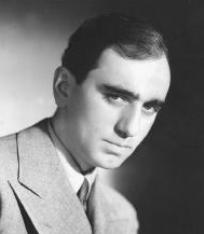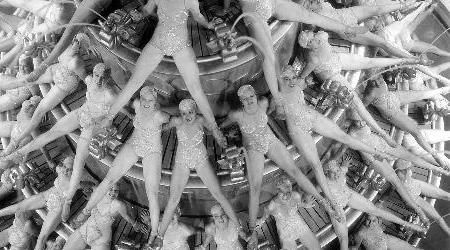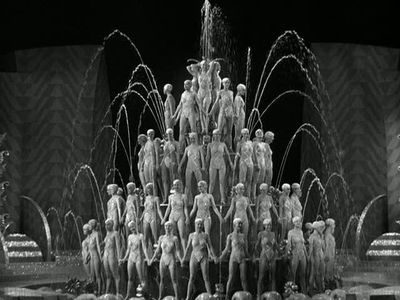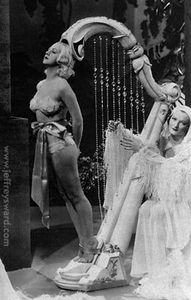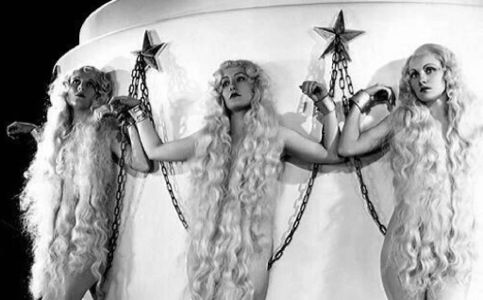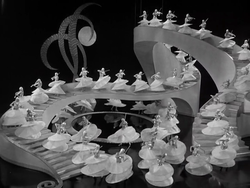Busby Berkeley
Click here for Early Movie History category page |
Busby Berkeley (November 29, 1895 – March 14, 1976), born William Berkeley Enos in Los Angeles, California, was a highly influential Hollywood movie director and musical choreographer.
Berkeley was famous for his elaborate musical production numbers that often involved complex geometric patterns. Berkeley's quintessential works used legions of showgirls and props as fantastic elements in kaleidoscopic on-screen performances. He started as a theatrical director, just as many other movie directors. Unlike many at the time, he felt that a camera should be allowed mobility, and he framed shots carefully from unusual angles to allow movie audiences to see things from perspectives that the theatrical stage never could provide. This is why he played an enormous role in establishing the movie musical as a category in its own right.
Career
He made his stage debut at five, acting in the company of his performing family. During World War I, Berkeley served as a field artillery lieutenant, where he learned the intricacies of drilling and disciplining large groups of people. During the 1920s, Berkeley was a dance director for nearly two dozen Broadway musicals, including such hits as ‘A Connecticut Yankee’. As a choreographer, Berkeley was less concerned with the terpsichorean skill of his chorus girls as he was with their ability to form themselves into attractive geometric patterns. His musical numbers were among the largest and best-regimented on Broadway. The only way they'd get any larger was if Berkeley moved to films, and he did when 'talkies' arrived.
His earliest movie jobs were on Samuel Goldwyn's Eddie Cantor musicals, where he began developing such techniques as a "parade of faces" (individualising each chorus girl with a loving close-up), and moving his dancers all over the stage (and often beyond) in as many kaleidoscopic patterns as possible. Berkeley's legendary top shot technique (the kaleidoscope again, this time shot from overhead) appeared seminally in the Cantor films, and also the 1932 Universal programmer Night World. His numbers were known for starting out in the realm of the stage, but quickly exceeding this space by moving into a time and place that could only be cinematic, only to return to shots of an applauding audience and the fall of a curtain. As choreographer, Berkeley was allowed a certain degree of independence in his direction of musical numbers, and they were often markedly distinct from (and sometimes in contrast to) the narrative sections of the films. The numbers he choreographed were mostly upbeat and focused on decoration as opposed to substance; one exception to this is the number "Remember My Forgotten Man" fromGold Diggers of 1933, which dealt with the treatment of soldiers in a post-WWI-Depression.
- From Roman Scandals
Berkeley's popularity with an entertainment-hungry Great Depression audience was secured in 1933, when he choreographed three musicals back-to-back for Warner Brothers: 42nd Street, Footlight Parade and the aforementionedGold Diggers of 1933. Berkeley's innovative and often sexually-charged dance numbers have been analyzed at length by cinema scholars. In particular, the numbers have been critiqued for their display (and some say exploitation) of the female form as seen through the "male gaze", and for their depiction of collectivism (as opposed to traditionally American rugged individualism) in the spirit of Roosevelt's New Deal. Berkeley always denied any deep significance to his work, arguing that his main professional goals were to constantly top himself and to never repeat his past accomplishments.
As the outsized musicals in which Berkeley specialised became passé, he turned to straight directing, begging Warners to give him a chance at drama. The result was 1939's They Made Me a Criminal, one of John Garfield's best films. Berkeley's drive for perfection led to a number of well-publicised run-ins with MGM stars such as Judy Garland. In 1943, he was removed as director of Girl Crazy because of disagreements with Garland, although the lavish musical number "I Got Rhythm", which he directed, remained in the picture. (Hugh Fordin, The World of Entertainment: The Freed Unit at MGM, 1975)
His next stop was at 20th Century-Fox for 1943's The Gang's All Here, in which Berkeley choreographed Carmen Miranda's outrageous ‘Lady in the Tutti-Frutti Hat’ number. The film made money, but Berkeley and the Fox brass disagreed over budget matters. Berkeley returned to MGM in the late 1940s, where among many other accomplishments he conceived the Technicolor finales for the studio's Esther Williams films. Berkeley's final film as choreographer was MGM's Billy Rose's Jumbo (1962).
Personal life
In private life, Berkeley was as flamboyant as his work. He went through six wives, an alienation of affections lawsuit involving a prominent movie queen, and a fatal car accident which resulted in his being tried and acquitted of second degree murder. In the late 1960s, the camp craze brought the Berkeley musicals back to the forefront. He toured the college and lecture circuit, and even directed a 1930s-style cold medication commercial, complete with a top shot of a dancing clock. In his 75th year, Busby Berkeley returned to Broadway to direct a successful revival of No No Nanette, starring his old Warner Brothers colleague and “42nd Street” star Ruby Keeler.
Berkeley died in 1976 in Palm Springs, California at the age of 80 from natural causes.
Cultural References
- The Magnetic Fields references Busby Berkeley in the album 69 Love Songs in the song "Busby Berkeley Dreams" and "The Way You Say Goodnight".
- "Busby Berkeley" is used as a descriptor for "drunk" in The Venture Bros.' episode "Showdown at Cremation Creek".
- In the film Blazing Saddles, Dom DeLuise plays a cameo role as a director similar to Busby Berkeley.
- Ryan Stiles has been known to be subjected to some Busby Berkeley-related scenario in at least one episode of Whose Line.
- The "Miss Piggy's Fantasy" music number from The Great Muppet Caper (1981) involving Miss Piggy and a number of chorus girls are directly influenced by the aesthetic.
- "The Wonderful Tundra" is a song by The Whiskers about millions of polar bears dancing in unison, and contains the line "Busby Berkeley would be so proud of them I bet he'd like to personally pat each and every one of them on their backs."
- In "Hollywood Babble On II," an issue of Shade, The Changing Man, the opening sequence is "just like a Busby Berkeley movie" except all of the performers are plucked from their "ordinary folk" activities and thus unsynchronized until they are all devoured by a shark they fail to jump.
- Busby Berkeley is referenced in the lyrics of the song "Da' Girlz, They Luv Me" by R.A. The Rugged Man on his album Die, Rugged Man, Die
- In the British 2006 film Confetti in which three couples compete to have the most original wedding to win a house, one couple have a Hollywood Musicals themed wedding based on the films of Busby Berkeley.
- The music video for the Take That single, "Shine" was inspired by the work of Busby Berkeley.
- The ending sequence of the film Jackass Number Two, in which the actors spoof a highly stylized dance number, is based largely on Busby Berkeley's work.
- In the film The Big Lebowski, actor Jeff Bridges has a psychedelic dream sequence that mimics the style of Berkeley's choreography
- The new bonds kaledioscope advertisement is influenced by the stylings of Busby Berkeley
Selected works
- The following filmograhy includes just some of the movies he worked on and stars he worked with
- A Connecticut Yankee (1927) (Broadway) Will Rogers, Maureen O'Sullivan, Myrna Loy
- Whoopee! (1930) (choreographer) Eddie Cantor, George Olsen
- Kiki (1931) (choreographer) Mary Pickford, Reginald Denny. Fred Walton
- Palmy Days (1931) (choreographer) Eddie Cantor, Barbara Weeks, George Raft
- Flying High (1931) (choreographer) Bert Lehr, Charleen Grrenwood, Pat O'Brien, Guy Kibbee
- The Kid from Spain (1932) (choreographer) Eddie Cantor,Robert Young, Noah Beery
- 42nd Street (1933) (choreographer) Guy & Ruby Keeler, Ginger Rogers, Dick Powell
- Gold Diggers of 1933 (1933) (choreographer) Warren William, Joan Blondell, Guy Kibbee, Ginger Rogers
- Footlight Parade (1933) (choreographer) James Cagney, Joan Blondell, Ruby Keeler, Dick Powell,
- Roman Scandals (1933) (choreographer) Eddie Cantor, Jack Rutherford
- Fashions of 1934 (1934) (director/choreographer of musical numbers)
- Wonder Bar (1934) (designer of musical numbers) William Powell, Bette Davis, Hugh Herbert
- Dames (1934) (director/choreographer of musical numbers) Joan Blondell, Rub Keeler, Zasu Pitts, Dick Powell
- Gold Diggers of 1935 (1935) (also director) Dick Powell, Adolphe Monjou, Dorothy Dare
- In Caliente (1935) (director/choreographer of musical numbers) Dolores Del Rio, Leo Carillo, Judy Canova
- Gold Diggers of 1937 (1936) (director/choreographer of musical numbers) Dick Powell, Joan Blondell, Glenda Farrell
- Stage Struck (1936) (director) Dick Powell, Joan Blondell, Jeanne Madden
- The Singing Marine (1937) (director/choreographer of musical numbers) Dick Powell, Doris Weston, Jane Wyman
- Hollywood Hotel (1937) (director) Dick Powell, Lola Lane, Glenda Farell
- Gold Diggers in Paris (1938) (director/choreographer of musical numbers) Rudy Vallee, Rosemary Lane
- They Made Me a Criminal (1939) (director) John Garfield, "The Dead End Kids", Ann Sheridan, Leo Gorcey, Huntz Hall
- Broadway Serenade (1939) (director of finale) Mickey Rooney, Judy Garland, Guy Kibbee
- Babes in Arms (1939) (director) Mickey Rooney, Judy Garland, Leni Lynn, Anne Shoemaker
- Strike Up the Band (1940) (director) Mickey Rooney, Judy Garland, Paul Whiteman Orchestra
- Forty Little Mothers (1940) (director) Eddie Cantor, Rita Johnson, Bonita Granville
- Ziegfeld Girl (1941) (director of musical numbers) James Stewart, Judy Garland, Hedy Lamarr, Lana Turner, Jackie Cooper, Tony Martin, Eve Arden, Dan Daley
- Babes on Broadway (1941) (director) Mickey Rooney, Judy Garland,
- Lady Be Good (1941) (director of musical numbers) Eleanor Powell, Ann Sothern, Lionel Barrywoore, Red Skelton, Dan Dailey, Phil Silvers
- Cabin in the Sky (1943) (director of "Shine" sequence) Lena Horne , Louis Armstrong, Butterfly McQueen
- Girl Crazy (1943 (director of "I Got Rhythm" sequence) Mickey Rooney, Judy Garland, Rags Ragland, June Allson, Tommy Dorsey
- The Gang's All Here (1943) (director) Alice Faye, Carmen Miranda, Benny Goodman
- Cinderella Jones (1946) (director) Robert Alda (Alan Alda's father), Joan Leslie, Julie Bishop
- Take Me Out to the Ball Game (1949) (director) Frank Sinatra, Esther Williams, Gene Kelly, Edward Arnold
- Romance on the High Seas (1948) (choreographer) Jack Carson, Janis Page, Don DeFore, Doris Day
- Two Weeks with Love (1950) (choreographer) Jane Powell, Ricardo Montalban, Ann Harding,
- Call Me Mister (1951) (choreographer) Betty Grable, Dan Daley, Danny Thomas, Dale Robertson, Richard Boons,
- Two Tickets to Broadway (1951) (choreographer) Tony Martin, Janet Leigh, Gloria DeHaven, Eddie Bracken, Ann Miller
- Million Dollar Mermaid (1952) (choreographer) Esther Williams, Victor Mature, Walter Pidgeon
- Small Town Girl (1953) (choreographer) Jane Powell, Ann Miller, Billie Burke, Fay Wray, Nat "King" Cole
- Easy to Love (1953) (choreographer) Esther Williams, Van Johnson, Tony Martin, Caroll Baker
- Rose Marie (1954) (choreographer) Ann Blyth, Howard Keel, Fernando Lamas, Bert Lahr, Marjorie Main
- Billy Rose's Jumbo (1962) (choreographer) Doris Day, Jimmy Durante, Marta Raye, Billy Barty
- No, No, Nanette (1971) (production supervisor) (Broadway)
A Personal Note from Robin
Another name from the past, Busby Berkeley was the ultimate Dance choreographer. He staged lavish dance scenes, sometimes with nearly a dozen good-looking, sexily-clad young ladies in kaleidoscopic extravaganzas.
I have several VHS and CD collections of his work. The plots (if there was a plot) were often contrived and minimalistic, but the scenery (read eye-candy in todays' vernacular) was worth the time waiting for the dance scenes.
Search for Busby Berkeley videos on YouTube
Chat rooms • What links here • Copyright info • Contact information • Category:Root
